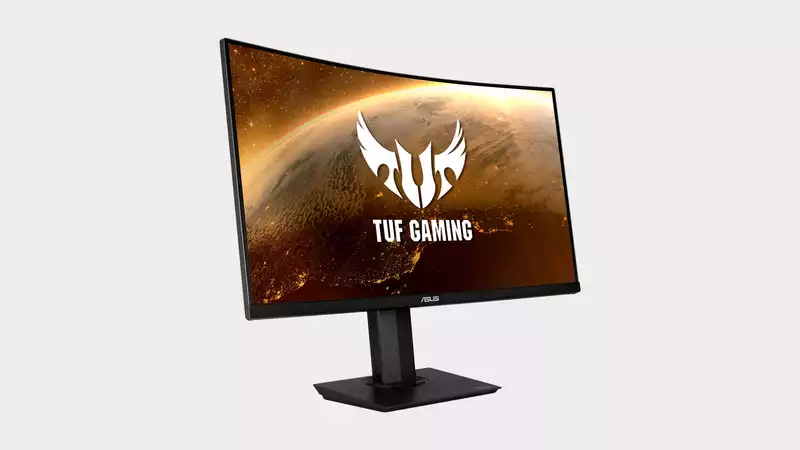Modern gaming monitors have become overly complex beasts that try to offer everything to everyone from hardcore gamers to precision colorists. This inevitably leads to compromises and blatantly high asking prices. Here's why I like the ASUS TUF Gaming VG32VQ. This $400 32-inch curved monitor focuses on the essentials, not the fancy feature list or outlandish design; the VG32VQ is focused on PC gamers and console owners who want a single monitor for gaming.
Therefore, ASUS equipped the VG32VQ with only three video input ports. An HDMI 2.0 port for consoles and a pair of DisplayPort 1.2 for high-speed PC gaming. The monitor also has built-in speakers, but the less said about the speakers the better. It's best to use headphones through the built-in headphone jack.The VG32VQ also supports HDR10, a standard more common on TVs than gaming monitors. This means that the Xbox One/Series X|S and PlayStation 4/5 consoles will recognize the VG32VQ as an HDR-compatible display.
Also, the large 32-inch display is curved, but so slightly that one forgets it is curved on the 1800R. Viewing angles are excellent, but at extreme angles the colors fade just a bit. The stand is a solid post on a polygonal base, and while it won't win any design awards, it certainly holds the heavy panel securely in place without wobbling. The monitor's height, tilt, and swivel are adjustable, but not rotatable. The overall aesthetic is quite utilitarian, made of durable plastic, and there are few RGB lights to be found.
The OSD menu buttons are the largest, chunkiest kind I have ever encountered on a monitor. They are easy to find without the fiddling that is common on fancier monitors. The buttons are densely packed close together, but easily distinguishable because of their alternating heights. I would prefer them to be located on the bottom bezel, where they would be easier to access, especially for left-handers.
The OSD menu itself is easy to navigate, with the various image settings and game extensions all laid out in a logical manner. You can also create and save up to four personalized image profiles, but we could not find a way to assign them to a quick action when pressing the menu button. That would have saved me from the tedium of trying to do simple tasks like changing brightness or typing.
The VG32VQ has a VA panel with native 1440p resolution. The first thing I noticed was the contrast and color saturation; a contrast ratio of 3,000:1 may not seem like much, but it is decent enough, and at a maximum brightness of 400 nits, everything looks punchy and vibrant. In fact, it does too. This monitor is not recommended for color-faithful work.
Nor could it be calibrated to obtain a reliable color profile. The game looks intuitive, but the dark areas of the image suffer and a lot of detail is lost. This can be a disadvantage in darker themed games such as Remnant Ashes, which I have been playing recently. Thankfully, there is a Shadowboost option, which is quite effective at brightening dark areas.
The monitor offers a number of image profiles called GameVisual. These adjust contrast, saturation, and shadowboost for different genres of content (not just games). I stuck mostly to the Cinema mode for gaming, which gives vibrancy without crushing the darks too much. sRGB mode is also available, which I guess is for professional/production work, but I wasn't satisfied with the color representation. Unfortunately, when running HDR on the console, there is no access to GameVisual.
However, most PC gamers won't care about HDR. Refresh and response is king, and 144Hz refresh, while rather old-fashioned these days, works beautifully. Adaptive sync games also run beautifully at higher frame rates. Asus also has its own "Extreme Low Motion Blur" (ELMB Sync) technology, which works in conjunction with Adaptive Sync to properly eliminate blurring UFO test (www.testufo.com),)を使用して、ELMB to see how effective Sync is at smoothing blurry images.
Tested VG32VQ on an NVIDIA GeForce RTX 3070 running Adaptive Sync; playthroughs of Apex Legends, Fortnite, and Doom Eternal all without tearing, stuttering, or ghosting, We easily recorded 160-190 fps, and if you play competitive shooters like Valorant or CS:GO, this monitor will not disappoint.
The ASUS TUF Gaming VG32VQ is a great budget monitor that I have enjoyed playing all kinds of PC and console games. However, I would not recommend it to anyone whose work requires color accuracy. Also, the lack of a USB port is a bit disappointing, but if you're looking for a 32" curved monitor with HDR10 and ELMB Sync for $400, I'd rather go with the TUF.
If this isn't what you've been looking for, be sure to check out our guide to the best gaming monitors.
.

Comments